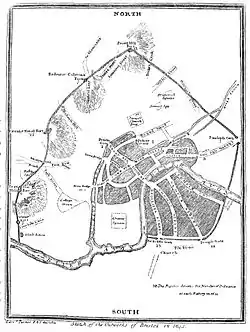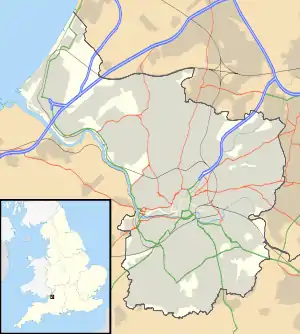Storming of Bristol
The Storming of Bristol took place on 26 July 1643, during the First English Civil War. The Royalist army under Prince Rupert captured the important port of Bristol from its weakened Parliamentarian garrison. The city remained under Royalist control until the second siege of Bristol in September of 1645.
| Storming of Bristol | |||||||
|---|---|---|---|---|---|---|---|
| Part of the First English Civil War | |||||||
 Map of Bristol's fortifications in 1644 | |||||||
| |||||||
| Belligerents | |||||||
|
|
| ||||||
| Commanders and leaders | |||||||
| Prince Rupert | Nathaniel Fiennes | ||||||
| Strength | |||||||
| Unknown |
300 horse 1,500 foot 100 guns | ||||||
| Casualties and losses | |||||||
| Unknown | Unknown | ||||||
 Bristol Location within Bristol | |||||||
Background
During the mid-17th century, Bristol had been one of the most important cities in England, second only to London in wealth. The Royalists had failed to secure it when the civil war began, leaving it under Parliamentarian control although there were many Royalist sympathisers within the city. In July 1643, the city's garrison was weakened when several of its units were detached to reinforce a Parliamentarian field army under Sir William Waller. On 13 July, Waller's army was destroyed at the Battle of Roundway Down.[1]
The Royalists quickly realised that this presented them with a great opportunity to capture important Parliamentarian-held towns in the south-west of England. Only two days after the battle, Prince Rupert marched from Oxford, the Royalists' wartime capital, with a large army. He also sent orders to the Royalist western army which had been victorious at Roundway Down, now under the command of his younger brother Prince Maurice, to march against Bristol from the south while he himself advanced on the city from the north.[2]
Defences
The Parliamentarian defenders of Bristol were commanded by Colonel Nathaniel Fiennes. His garrison consisted of 300 cavalry and 1,500 infantry, plus some poorly-armed town militia. The fortifications consisted of an inner wall immediately surrounding the city and resting on the Rivers Avon and Frome plus a five-mile circuit of walls and forts surrounding the inner walls. To the south and east the outer wall was a continuous barrier consisting of a curtain wall and ditch on low-lying ground; to the north and west, the defenses consisted of a chain of forts and batteries resting on the high ground overlooking the city, linked by a low earth wall.[1] A total of 100 guns were distributed along the defences.
Royalist plan
Prince Rupert personally led a reconnaissance of the defences to the north of the city on 23 July. There were some clashes between Royalist parties left on Clifton Hill and Parliamentarian sorties. The Parliamentarians were beaten off.[3]
The Royalists invested Bristol on the morning of 24 July. Rupert formally summoned the city to surrender, but the summons was refused. He then crossed the Avon to confer with Prince Maurice and his officers. There was some dissension. Prince Maurice with his Cornish infantry faced the stronger defences south of Bristol and preferred to undertake a formal siege and bombardment. Prince Rupert however, believed that the defences to the north were vulnerable to a storming attempt given the weak state of the garrison. Eventually, Prince Rupert prevailed, and the attack was planned to begin early on 26 July. The signal for the attack was to be a salvo from a Royalist battery facing the Prior's Hill Fort at the northern point of the defences.[4]
Attack
When the morning came, the execution of the plan was uncoordinated. The eager Cornish infantry attacked prematurely at 3:00 am, forcing Prince Rupert to fire the signal to attack earlier than he intended.
South
The Cornish infantry attacked in three columns.[1] They rolled carts and wagons into the ditch in front of the wall to fill it and allow them to cross. The ditch, however, was too deep and this approach failed. The Cornish then tried using faggots and scaling ladders to continue the attack. The Royalists suffered heavy casualties including the death of all three commanders of the attacking columns[1] and were eventually driven back.[5]
North
Prince Rupert's attackers consisted of three brigades of infantry, with some dragoons. Lord Grandison's brigade attacked the Prior's Hill Fort and a nearby redoubt at Stokes Croft, but was repulsed. Grandison himself was killed. Sir John Belasyse's brigade was also unsuccessful at Colston's Mount. Prince Rupert had a horse killed under him while rallying Belasyse's infantry.[1]
The brigade under Colonel Henry Wentworth was more successful. Led by dragoons under Colonel Henry Washington, they penetrated a re-entrant between the Brandon Hill and Windmill Hill forts and found that once they reached a certain point they were in "dead ground," safe from the fire of either fort. They threw grenades over the wall to drive back the defenders, while they pulled down the wall using halberds and partisans. Once they were inside the defences, Fiennes's cavalry tried to counter-attack, but flinched when they faced Royalists wielding "fire-pikes",[1] pikes to which fireworks were attached.[5]
Wentworth's brigade pushed forward towards the inner defences, followed by Belasyse's brigade and Colonel Arthur Aston's regiment of cavalry.[6] They captured another strongpoint, the "Essex Work", when the defenders panicked. There was severe fighting for two hours around the Frome Gate, part of the inner defences, as some of the townswomen tried to improvise a barricade of woolsacks behind the gate.[7]
Surrender and aftermath
Prince Rupert had sent for the Cornish infantry to reinforce the attack, but at about 6 pm, Fiennes asked for terms. Prince Rupert granted easy conditions. The defenders were allowed to march out with their personal property, while their officers (and the cavalry troopers) were allowed to keep their arms. Undisciplined Royalists, nevertheless, plundered the defenders when they marched out on 27 July.[7]
The Royalists secured immense amounts of booty, in particular munitions of war. Eight armed merchant ships were captured, which later formed the nucleus of a Royalist fleet.[8] The workshops of Bristol eventually re-equipped the entire Royalist army with muskets.
Fiennes was tried by Parliament and sentenced to death, but reprieved.[9]
See also
Citations
- Plant, The Sieges of Bristol & Gloucester, 1643.
- Young & Holmes (2000), p. 138.
- Young & Holmes (2000), p. 139.
- Rogers (1968), pp. 92-93.
- Young & Holmes (2000), p. 140.
- Rogers (1968), p. 93.
- Young & Holmes (2000), p. 141.
- Rogers (1968), p. 94.
- Plant, Nathaniel Fiennes, 1610–69.
References
- Plant, David (1 November 2008). "Nathaniel Fiennes, 1610–69". BCW Project. David Plant. Retrieved 27 August 2008.
- Plant, David (27 December 2009). "The Sieges of Bristol & Gloucester, 1643". BCW Project. David Plant. Retrieved 27 August 2008.
- Rogers, Col. H.C.B. (1968). Battles and Generals of the Civil Wars, 1642-1651. Seeley Service & Co. Ltd.
- Young, Peter; Holmes, Richard (2000). The English Civil War (Wordsworth ed.). Ware. ISBN 1-84022-222-0.